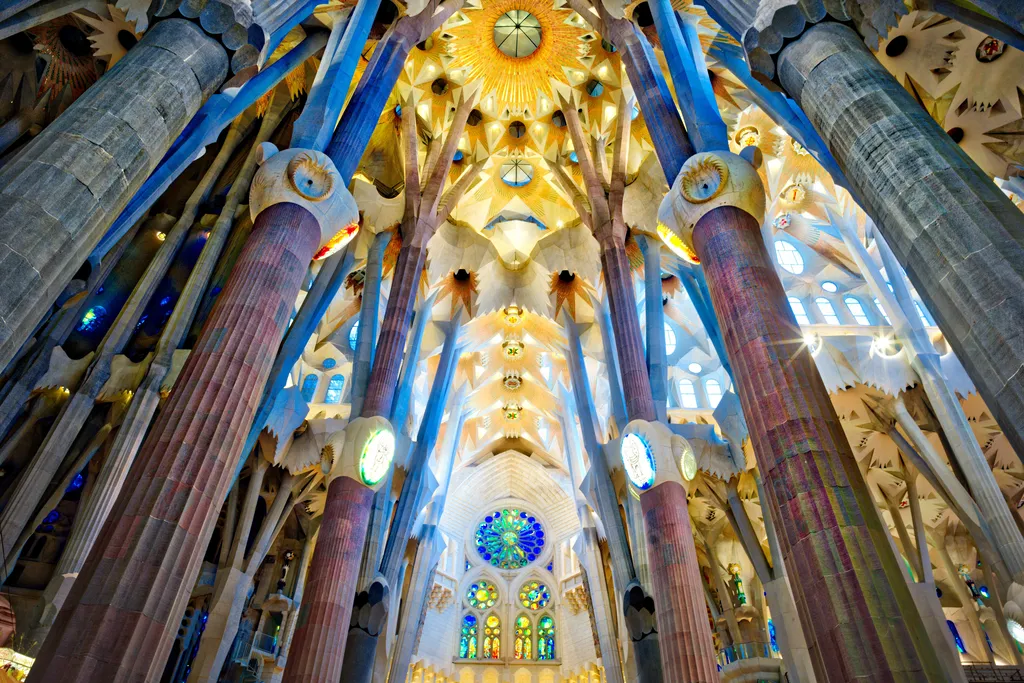As His 143-Year-Old Church Nears Completion, Architect Antoni Gaudí Is Placed on the Path to Sainthood
As His 143-Year-Old Church Nears Completion, Architect Antoni Gaudí Is Placed on the Path to Sainthood
Gaudí, nicknamed “God’s architect,” was declared “venerable” by Pope Francis this week, putting him one step closer to canonization
Lillian Ali
- Staff Contributor
April 16, 2025 11:22 a.m.
The interior of the Sagrada Familia, the unfinished basilica in Barcelona, Spain
Trey Ratcliff / CC BY-NC-SA 2.0
The Sagrada Familia has faced the Spanish Civil War, fires, the COVID-19 pandemic and periods of economic growth and downturn. The ambitious church, situated in the Eixample district of Barcelona, is in its final phase of construction. Initial construction began on the church in 1882, and after 143 years of work, architect Antoni Gaudí’s masterpiece is almost complete.
Now, almost 100 years after his death and before the church is completed, the Vatican has placed Gaudí on a path that could end in sainthood. On Monday, April 14, Pope Francis, who was recently discharged from a five-week hospitalization, recognized “the heroic virtues of the servant of God” Antoni Gaudí i Cornet.
Gaudí was born in Spain on June 25, 1852. He studied architecture in Barcelona and, at the age of 31, took over the construction of the Sagrada Familia in 1883. He worked on the church for 40 years, and it has remained unfinished. Currently, it is set to be completed in 2026.
For his work on the church and his devout Catholic faith, Gaudí is nicknamed “God’s architect.” Italian historian Giovanni Maria Vian describes the Sagrada Familia as “the last great church” in Europe. He tells the New York Times’ Elisabetta Povoledo that Gaudí was “a Christian visionary, so the cause for beatification,” one of the steps toward sainthood, “is more than merited.”
Seven of Gaudí’s works, including the Sagrada Familia, are UNESCO World Heritage sites.
In 2010, Pope Benedict XVI consecrated the basilica, declaring it sacred before an audience of more than 6,500. In his dedication, Benedict quoted Gaudí as saying that a church is “the only thing worthy of representing the soul of a people, for religion is the most elevated reality in man.”
Gaudí's Casa Milà, recognized as a UNESCO World Heritage site, was built for a couple in the Eixample district of Barcelona.
Shaun Dunmall / CC BY-SA 2.0.
The sainthood process is called canonization. To begin the process, someone formally requests consideration of the deceased for sainthood, at least five years after their death. A bishop and eventually the Vatican evaluate whether there is enough evidence for consideration. If there is, the deceased is named a “servant of God.”
Then a bishop sends a formal report to the Dicastery for the Causes of Saints, where the deceased person’s life is examined to ensure alignment with the Catholic Church’s teachings. If the deceased passes this step, they are declared “venerable.”
The formal cause for Gaudí’s sainthood was submitted to the Vatican in 2023, according to the New York Times. He was officially declared “venerable” on Monday.
Next is beatification, or to be declared “blessed.” The deceased has to have been a martyr or brought about a verified miracle. Beatification opens the door for official canonization, which requires proof of a second miracle. The pope ultimately decides whether to canonize someone. If he does, a special Mass is held in the new saint’s honor.
In Gaudí’s case, beatification would likely require proof of a miracle attributed to him after his 1926 death, reports the BBC News’ Hafsa Khalil.
The movement by Gaudí’s community and supporters to push him toward sainthood goes back decades, with many believing that divine inspiration motivated his architecture. In 2003, the Guardian’s Giles Tremlett reported that Barcelona’s then-Cardinal Ricardo María Carles Gordó asked, “can anyone acquainted with [Gaudí’s] work believe that all which one contemplates could possibly have been produced only by cold thought?”
Art historian Lourdes Cirlot told the BBC’s Jo Fidgen and William Kremer in 2015 that “it is hard to say that a building can be miraculous. But if someone goes into the Sagrada Familia, and really believes that they'll be cured, it will probably happen.”
Get the latest stories in your inbox every weekday.
More about:
Architecture
Christianity
Spain


